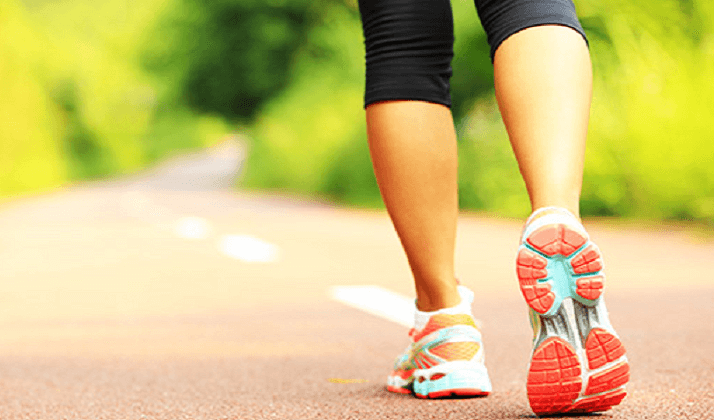3 Physical Activities Your Brain Loves

We all know that exercise is great for your brain. Physical activity oxygenates the blood and stimulates circulation, both of which are beneficial for your brain. It improves and sharpens intellectual functions and perception. But that’s not all. It also inhibits the production of cortisol, the stress hormone, and therefore keeps your emotions more balanced.
Something else physical activity does to your brain is fostering a state of well-being and happiness. That’s because exercise stimulates the production of serotonin. This chemical change makes us feel better.
“Dancing is like dreaming with your feet.”
-Constanze-
An interesting study was done on the subject. Researchers wanted to see what the benefits of walking, dancing, and stretching were. They wondered which of these three activities had the most positive effects. To find out, they conducted an experiment using a group of volunteers. Let’s look at their conclusions and see what physical activities your brain loves.
Physical activities your brain loves: an experiment
The first thing researchers did was form a group of volunteers, 174 in total. All of them were people over 60, and some were over 70. It’s common knowledge that there is a degeneration of white matter in the brain at these ages. This has many different effects, such as memory loss and a breakdown of cognitive functions in general.

All the volunteers lived rather sedentary lifestyles. Most of them did not do any physical activity. Those who exercised only did so very sporadically and for short periods. It was the ideal group for looking at what changes occur in the brain due to physical activity.
At the beginning, they were all tested aerobically. They also underwent tests to determine their cognitive capacity and their data-processing speed. These tests served as the baseline for the volunteers.
Physical activities your brain loves: a comparison
The group of volunteers was divided into three subgroups, each individual placed in a subgroup randomly. The first of these groups started a walking program. The members had to walk, at a brisk marching pace, for one hour, three times a week.

The second subgroup did stretches. They performed muscle stretching exercises three times a week. They also did supervised balancing exercises and other similar activities.
The third group had to go to a dance studio three times a week. Not only did they have to dance, they also had to learn a choreography. The choreography gradually got more complex. They used a simple rhythm as the base: country music.
Physical activities your brain loves: conclusions
The experiment lasted a period of six months. At the end of that time, researchers used tomographies and MRI’s to verify the type of changes that had occurred in the brain. Some results lined up with what was expected, but others were truly amazing.
At first, the most remarkable thing was that the white matter of the brain was further deteriorated in participants who had led a more sedentary life before the experiment. But there was visible improvement in all of the participants. All of them got better results in the cognitive and memory tests than they had at the beginning of the experiment.

The big surprise was with the results of the third group. This was the group that had spent time learning a complex dance choreography. All their measures were better than the others.
The experts indicated that this was because physical activity was accompanied by a mental, social, and recreational activity. Therefore, it was more complete. In fact, in many participants, researchers observed an increase in the density of the white matter in the brain.
Agnieszka Burzynska, one of the research directors, said that a similar study had been been done in 2014. At the time, it could be proven that the longer a person sat, the more his brain deteriorated, even if he exercised at the end of the day.
Therefore, the overall conclusion is twofold. First, living a sedentary lifestyles affects the brain. Second, physical activity reactivates the brain. And the bonus conclusion? Out of all the physical activities your brain loves, dance is the most effective.
We all know that exercise is great for your brain. Physical activity oxygenates the blood and stimulates circulation, both of which are beneficial for your brain. It improves and sharpens intellectual functions and perception. But that’s not all. It also inhibits the production of cortisol, the stress hormone, and therefore keeps your emotions more balanced.
Something else physical activity does to your brain is fostering a state of well-being and happiness. That’s because exercise stimulates the production of serotonin. This chemical change makes us feel better.
“Dancing is like dreaming with your feet.”
-Constanze-
An interesting study was done on the subject. Researchers wanted to see what the benefits of walking, dancing, and stretching were. They wondered which of these three activities had the most positive effects. To find out, they conducted an experiment using a group of volunteers. Let’s look at their conclusions and see what physical activities your brain loves.
Physical activities your brain loves: an experiment
The first thing researchers did was form a group of volunteers, 174 in total. All of them were people over 60, and some were over 70. It’s common knowledge that there is a degeneration of white matter in the brain at these ages. This has many different effects, such as memory loss and a breakdown of cognitive functions in general.

All the volunteers lived rather sedentary lifestyles. Most of them did not do any physical activity. Those who exercised only did so very sporadically and for short periods. It was the ideal group for looking at what changes occur in the brain due to physical activity.
At the beginning, they were all tested aerobically. They also underwent tests to determine their cognitive capacity and their data-processing speed. These tests served as the baseline for the volunteers.
Physical activities your brain loves: a comparison
The group of volunteers was divided into three subgroups, each individual placed in a subgroup randomly. The first of these groups started a walking program. The members had to walk, at a brisk marching pace, for one hour, three times a week.

The second subgroup did stretches. They performed muscle stretching exercises three times a week. They also did supervised balancing exercises and other similar activities.
The third group had to go to a dance studio three times a week. Not only did they have to dance, they also had to learn a choreography. The choreography gradually got more complex. They used a simple rhythm as the base: country music.
Physical activities your brain loves: conclusions
The experiment lasted a period of six months. At the end of that time, researchers used tomographies and MRI’s to verify the type of changes that had occurred in the brain. Some results lined up with what was expected, but others were truly amazing.
At first, the most remarkable thing was that the white matter of the brain was further deteriorated in participants who had led a more sedentary life before the experiment. But there was visible improvement in all of the participants. All of them got better results in the cognitive and memory tests than they had at the beginning of the experiment.

The big surprise was with the results of the third group. This was the group that had spent time learning a complex dance choreography. All their measures were better than the others.
The experts indicated that this was because physical activity was accompanied by a mental, social, and recreational activity. Therefore, it was more complete. In fact, in many participants, researchers observed an increase in the density of the white matter in the brain.
Agnieszka Burzynska, one of the research directors, said that a similar study had been been done in 2014. At the time, it could be proven that the longer a person sat, the more his brain deteriorated, even if he exercised at the end of the day.
Therefore, the overall conclusion is twofold. First, living a sedentary lifestyles affects the brain. Second, physical activity reactivates the brain. And the bonus conclusion? Out of all the physical activities your brain loves, dance is the most effective.
This text is provided for informational purposes only and does not replace consultation with a professional. If in doubt, consult your specialist.







